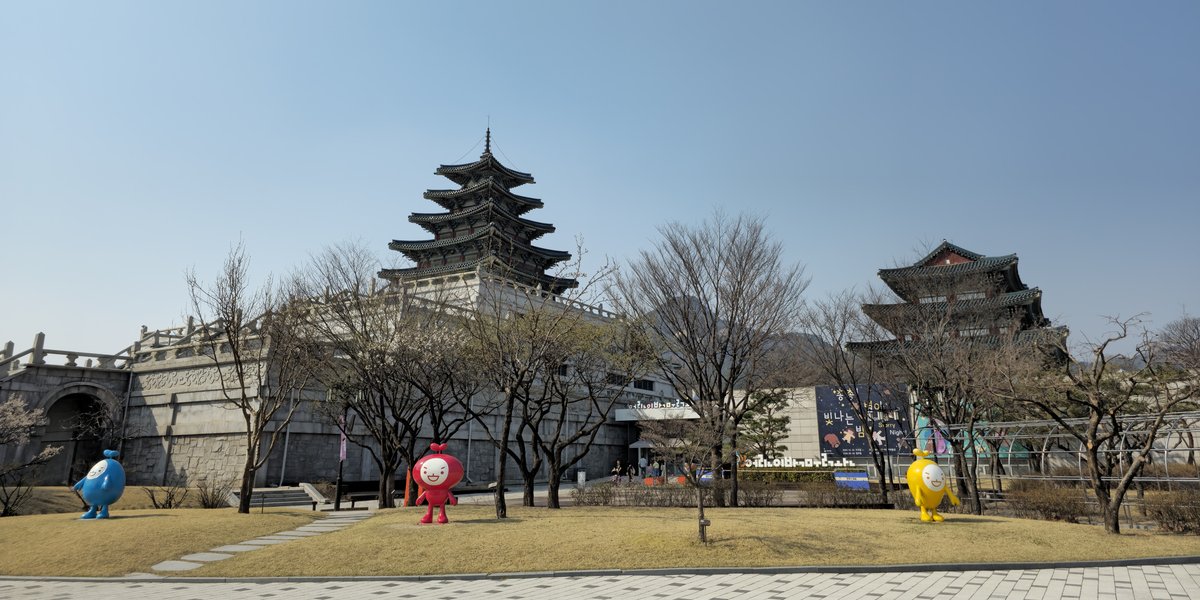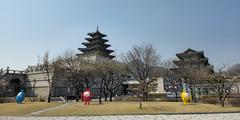
National Folk Museum of Korea: Visiting Hours, Tickets, and Seoul Historical Sites Guide
Date: 14/06/2025
Introduction
The National Folk Museum of Korea, situated within the historic Gyeongbokgung Palace grounds in Seoul, serves as a vibrant portal to Korea’s folk traditions and daily life. Established during the nation’s rapid modernization, the museum’s mission is to preserve, educate, and celebrate Korea’s cultural heritage. Home to over 4,000 artifacts—ranging from prehistoric tools and traditional garments to reconstructed village scenes—the museum offers immersive exhibits that chronicle the lives and customs of Koreans from ancient times through the Joseon Dynasty (Maps of World; National Folk Museum of Korea).
The building itself blends traditional Korean architectural motifs, such as a pagoda-inspired roof, with modern design, reinforcing the museum’s role as a bridge between past and present. Free to the public and easily accessible by subway, the museum is a central attraction in Seoul’s cultural landscape, attracting both local and international visitors (Lonely Planet; Trip.com).
Table of Contents
- Origins and Historical Development
- Exhibition Halls and Artifact Collections
- Museum Architecture and Setting
- Practical Visitor Information
- Travel Tips and Nearby Attractions
- Cultural Significance and Educational Role
- Preservation, Research, and National Identity
- Frequently Asked Questions (FAQs)
- Plan Your Visit
- References
Origins and Historical Development
Founded in the post-war era, the National Folk Museum of Korea was established to safeguard Korea’s folk heritage amid rapid social change. Through extensive research, fieldwork, and community donations, the museum has curated an expansive collection that reflects the diversity of Korean society from prehistory to the end of the Joseon Dynasty in 1910 (Maps of World). Its mission extends beyond collection and display to encompass educational programming and cultural preservation (Thrillophilia).
Exhibition Halls and Artifact Collections
The museum’s exhibits are organized into three main indoor halls and a Donation Hall, each focusing on different aspects of Korean folk life (Maps of World):
-
Hall 1: History of the Korean People
Explores Korea’s evolution from prehistoric settlements to the Joseon Dynasty, featuring ancient tools, pottery, and detailed models of early communities. -
Hall 2: Korean Way of Life
Immerses visitors in traditional homes, workshops, and communal spaces, displaying household utensils, hanbok, and agricultural tools. -
Hall 3: Life Cycle of Koreans
Dedicates exhibits to birth, coming of age, marriage, and death rituals, emphasizing Confucian values and ancestral rites through ceremonial garments and ritual artifacts. -
Donation Hall
Showcases personal items donated by Korean families, offering intimate glimpses into Korea’s regional diversity.
An outdoor exhibition area features life-size replicas of thatched houses, market stalls, and agricultural implements, allowing visitors a hands-on experience of Korea’s rural past (Thrillophilia).
Museum Architecture and Setting
Architectural Philosophy and Design
The museum’s architecture harmonizes traditional and modern elements, featuring a pagoda-shaped roof reminiscent of Korea’s historic temples. Built with stone, wood, and tile, and integrated with natural surroundings, the design evokes both security and openness—key themes in traditional Korean architecture.
Location and Accessibility
Located at 37 Samcheong-ro, Jongno-gu, within Gyeongbokgung Palace’s northeast corner, the museum is accessible via Gyeongbokgung Station (Line 3, Exit 5). Entry is possible through a dedicated museum entrance, and the site is near other landmarks such as Bukchon Hanok Village and Insadong (Trip.com).
Interior and Exterior Spaces
Inside, three permanent exhibition halls and a Children’s Museum provide a comprehensive narrative of Korean folk culture. The grounds include open-air exhibits with reconstructed traditional buildings and a model 20th-century street, enhancing the visitor experience (The Seoul Guide).
Conservation and Accessibility
The museum employs advanced environmental controls for artifact preservation, energy-efficient systems, and is fully accessible, with ramps, elevators, and multilingual information (Ktravelinfo).
Practical Visitor Information
Visiting Hours
- March–May / September–October: 09:00–18:00
- June–August: 09:00–18:30
- November–February: 09:00–17:00
- Last admission: 1 hour before closing
- Closed: Tuesdays and select holidays (NFM Visiting)
Tickets
- Admission is free. However, entering via the main palace gate may require a Gyeongbokgung Palace ticket (₩3,000); wearing a hanbok grants free palace entry (Away to the City).
Guided Tours
- Free English tours daily (except Tuesdays) at 10:30 and 14:30, starting at Exhibition Hall 1 (The Seoul Guide).
Directions
- Subway: Gyeongbokgung Station (Line 3, Exit 5), or Anguk Station (Line 3, Exit 1).
- Numerous bus routes serve the Jongno-gu area.
Accessibility
- Fully accessible with ramps, elevators, accessible restrooms, and information in multiple languages.
Facilities and Amenities
- Clean restrooms, lockers, museum shop, and a café (plus nearby eateries in Insadong and Samcheong-dong).
- Family-friendly: Children’s Museum offers interactive programs (advance reservation recommended).
Travel Tips and Nearby Attractions
- Best time to visit: Weekday mornings for fewer crowds; spring and fall offer pleasant weather.
- Combine your visit: Plan to explore Gyeongbokgung Palace, Bukchon Hanok Village, Insadong, and Jogyesa Temple.
- Photo opportunities: Both the museum and palace grounds are highly photogenic.
- Hanbok experience: Rental shops nearby; wearing hanbok grants free palace entry (Away to the City).
- Check events: The museum hosts folk performances, craft fairs, and seasonal festivals around Seollal (Lunar New Year) and Chuseok.
Cultural Significance and Educational Role
The museum plays a vital role in safeguarding and sharing Korea’s intangible heritage. Through exhibits, workshops, and performances, it promotes values such as respect for elders, community, and harmony with nature. Director General Cheon Jingi articulates the museum’s mission as one of accessibility and emotional engagement, realized through interactive and educational programming (Korea.net).
Annual events like the Seollal celebration foster intergenerational connections and community spirit. Educational activities and international collaborations further the museum’s reach and impact (Thrillophilia).
Preservation, Research, and National Identity
As a leading research center, the museum documents oral histories, traditional crafts, and festivals, ensuring the preservation and transmission of folk knowledge. Its exhibitions and outreach highlight Korea’s evolving identity and the relevance of traditional values in contemporary society (Korea.net).
Frequently Asked Questions (FAQs)
Q: What are the National Folk Museum of Korea’s visiting hours?
A: Generally 09:00–18:00 (seasonal variations); last admission one hour before closing; closed Tuesdays.
Q: Is admission free?
A: Admission to the museum is free. Palace entry may require a ticket unless you wear a hanbok.
Q: Are guided tours available?
A: Yes, free English tours are offered daily except Tuesdays.
Q: Is the museum accessible?
A: Yes, the museum provides barrier-free facilities and multilingual services.
Q: Can I take photographs?
A: Photography is permitted in most areas; flash and tripods may be restricted.
Q: What are nearby attractions?
A: Gyeongbokgung Palace, Bukchon Hanok Village, Insadong, and Jogyesa Temple.
Q: Are there special exhibitions or events?
A: Yes, check the official website for current schedules and events.
Plan Your Visit
- Address: 37 Samcheong-ro, Jongno-gu, Seoul, South Korea
- Phone: +82-2-3704-3114
- Website: https://www.nfm.go.kr/
To enhance your visit, download the Audiala app for guided tours, up-to-date information, and exclusive content on Seoul’s historical sites.
Summary and Travel Tips
The National Folk Museum of Korea is a cornerstone for understanding Korea’s cultural legacy. Its engaging exhibitions, accessible facilities, and central location make it ideal for families, students, and travelers alike. To maximize your experience, attend guided tours, participate in workshops, and check for seasonal events. For the latest updates, consult the official website and consider using digital resources to plan your visit.
References
- Maps of World
- National Folk Museum of Korea
- Trip.com
- Thrillophilia
- Korea.net
- Lonely Planet
- The Seoul Guide
- Away to the City
- Ktravelinfo
- NFM Visiting













































































































































































































